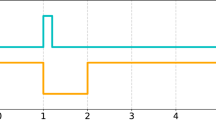Abstract
[Context and motivation] Formal pattern languages with a restricted English grammar, such as the pattern language of Konrad and Cheng, give us the possibility to combine human intuition and the rigour of a machine. [Question/problem] The question arises to what extent the intuitive understanding of such a pattern language is in agreement with its formal semantics. [Principal ideas/results] We present an empirical study to address this question. The existence of a formal semantics allows us to use the machine as an objective judge to decide if the intuitive understanding is correct. The study confirms empirically the practical usefulness of HanforPL in that the intuitive understanding matches the formal semantics in most practically relevant cases. The study reveals that a number of phrases of interest represent critical edge cases where even a prior exposure to formal logic is not a guarantee for the correct intuitive understanding. [Contribution] We show how the alignment of formal and intuitive semantics can be investigated, and that this alignment can not simply be assumed. Nonetheless, results regarding the understandability of HanforPL are favourable with high understandability in commonly used patterns. The results of the study will be the basis of improvements in HanforPL.
Access this chapter
Tax calculation will be finalised at checkout
Purchases are for personal use only
Similar content being viewed by others
References
Becker, S., et al.: Hanfor: semantic requirements review at scale. In: REFSQ Workshops. CEUR Workshop Proceedings, vol. 2857. CEUR-WS.org (2021)
Berry, D.M., Kamsties, E.: The syntactically dangerous all and plural in specifications. IEEE Softw. 22(1), 55–57 (2005)
Bjørner, D., Havelund, K.: 40 years of formal methods. In: Jones, C., Pihlajasaari, P., Sun, J. (eds.) FM 2014. LNCS, vol. 8442, pp. 42–61. Springer, Cham (2014). https://doi.org/10.1007/978-3-319-06410-9_4
Dietsch, D., Feo-Arenis, S., Westphal, B., Podelski, A.: Disambiguation of industrial standards through formalization and graphical languages. In: RE, pp. 265–270. IEEE Computer Society (2011)
Dietsch, D., Langenfeld, V., Westphal, B.: Formal requirements in an informal world. In: 2020 IEEE Workshop on Formal Requirements (FORMREQ), pp. 14–20. IEEE (2020)
Fischbach, J., Frattini, J., Mendez, D., Unterkalmsteiner, M., Femmer, H., Vogelsang, A.: How do practitioners interpret conditionals in requirements? In: Ardito, L., Jedlitschka, A., Morisio, M., Torchiano, M. (eds.) PROFES 2021. LNCS, vol. 13126, pp. 85–102. Springer, Cham (2021). https://doi.org/10.1007/978-3-030-91452-3_6
Giannakopoulou, D., Pressburger, T., Mavridou, A., Schumann, J.: Generation of formal requirements from structured natural language. In: Madhavji, N., Pasquale, L., Ferrari, A., Gnesi, S. (eds.) REFSQ 2020. LNCS, vol. 12045, pp. 19–35. Springer, Cham (2020). https://doi.org/10.1007/978-3-030-44429-7_2
Konrad, S., Cheng, B.H.C.: Real-time specification patterns. In: ICSE, pp. 372–381. ACM (2005)
Langenfeld, V., Dietsch, D., Westphal, B., Hoenicke, J., Post, A.: Scalable analysis of real-time requirements. In: RE, pp. 234–244. IEEE (2019)
Moitra, A., Siu, K., Crapo, A.W., et al.: Towards development of complete and conflict-free requirements. In: RE, pp. 286–296. IEEE (2018)
Post, A., Hoenicke, J.: Formalization and analysis of real-time requirements: a feasibility study at BOSCH. In: Joshi, R., Müller, P., Podelski, A. (eds.) VSTTE 2012. LNCS, vol. 7152, pp. 225–240. Springer, Heidelberg (2012). https://doi.org/10.1007/978-3-642-27705-4_18
Post, A., Menzel, I., Hoenicke, J., Podelski, A.: Automotive behavioral requirements expressed in a specification pattern system: a case study at BOSCH. Requir. Eng. 17(1), 19–33 (2012)
Post, A.C.: Effective correctness criteria for real-time requirements. Ph.D. thesis, University of Freiburg (2012)
Westphal, B.: On education and training in formal methods for industrial critical systems. In: Lluch Lafuente, A., Mavridou, A. (eds.) FMICS 2021. LNCS, vol. 12863, pp. 85–103. Springer, Cham (2021). https://doi.org/10.1007/978-3-030-85248-1_6
Winter, K., Femmer, H., Vogelsang, A.: How do quantifiers affect the quality of requirements? In: Madhavji, N., Pasquale, L., Ferrari, A., Gnesi, S. (eds.) REFSQ 2020. LNCS, vol. 12045, pp. 3–18. Springer, Cham (2020). https://doi.org/10.1007/978-3-030-44429-7_1
Yang, H., Roeck, A.N.D., Gervasi, V., Willis, A., Nuseibeh, B.: Analysing anaphoric ambiguity in natural language requirements. Requir. Eng. 16(3), 163–189 (2011)
Acknowledgements
We thank all participants, and Amalinda Post for forwarding the study.
Author information
Authors and Affiliations
Corresponding author
Editor information
Editors and Affiliations
Rights and permissions
Copyright information
© 2023 The Author(s), under exclusive license to Springer Nature Switzerland AG
About this paper
Cite this paper
Henkel, E., Hauff, N., Eber, L., Langenfeld, V., Podelski, A. (2023). An Empirical Study of the Intuitive Understanding of a Formal Pattern Language. In: Ferrari, A., Penzenstadler, B. (eds) Requirements Engineering: Foundation for Software Quality. REFSQ 2023. Lecture Notes in Computer Science, vol 13975. Springer, Cham. https://doi.org/10.1007/978-3-031-29786-1_2
Download citation
DOI: https://doi.org/10.1007/978-3-031-29786-1_2
Published:
Publisher Name: Springer, Cham
Print ISBN: 978-3-031-29785-4
Online ISBN: 978-3-031-29786-1
eBook Packages: Computer ScienceComputer Science (R0)




